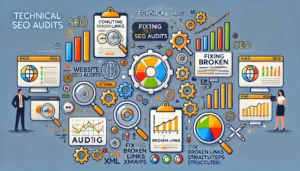Technical SEO is crucial as it helps optimise the website in terms of technical elements including its performance. It includes things like cures of broken links, development of XML sitemaps, and continuing SE audit. By dealing with these aspects, you make ways to allow search engines crawl your site meaning improving on users’ experience and high search ranking.
Understanding Technical SEO: Enhancing Website Performance and Crawlability for Better Rankings
It is also known as onsite SEO, it’s the core of SEO that deals with the improvement of all the technical features of your site for enhanced search engine ranking. They include aspects such as site speed, sitemap organization, and if there are duplicate contents you fix them so that your webpage is reachable. This we know also plays a big role in helping search engines crawl your site and index it optimally and in the process making your site to rank better for your targeted keywords and provide a better user experience.
Why Technical SEO is significant is possible only by focusing on the general impacts of websites by making them easier to crawl. It is always important that your site can be easily indexed by the Search Engines, for which you need an effectively created sitemap and URL structure. Optimization done properly not only elevates the ranking of your site but also deals with problems related to duplication of content, thus providing the best opportunity a webpage has to rank high.
Optimizing Architecture, Speed, and Mobile Usability: Best Practices for Technical SEO
Structural website optimization is a critical part of the general Technical SEO recommendations. More structure like good XML sitemaps and structural data such as schema make it easier for search engines to index pages. It also means that users can find your content easily through the search engine results page. Appropriate architecture avoids such problems as links malfunction and increases site usability and ranking – making your website perfect for users and search engines.
These two are very important when it comes to the Techniques of achieving good ranks in Technical SEO. Optimising page loading and, for example, reducing image size or the number of server calls increases the quality of the service. For mobile users, therefore, the website must employ what can be called as responsive designs that are compatible with all devices. Not only do these best practices increase user engagement but also the overall visibility of a site plays a role in achieving better ranking in a cut throat world on the World Wide Web.

Securing Your Site and Boosting Search Visibility: Key Aspects of Technical SEO
Technical SEO can be defined as vital changes aimed at enhancing the functionality, speed and security at the site. Use of HTTPS and SSL certificates makes your web page secure, helping build user trust hence a boost in your ranking. Also, they were useful in fixing other problems of duplicate content, where users used one page URL with many parameters and search engines had to choose the preferred canonical version of the page. About site auditor, there are other methods of doing the site audit through the Google search Console that can help monitor and rectify security or content issues making the site more effective.
Another of the components of this field is focused on improving the search exposure of a site with structured data and schema markup. These techniques also allow for the displays of rich snippets in the search results thus increasing the click through rates and users interaction. On page SEO should be incorporated with structured data in the content to render optimal understandability to web crawlers. Together with constant optimization and site audits, the condition of your Internet resource will be better, and therefore its ranking and popularity.
Enhancing Technical SEO: Fixing Errors, Optimising Sitemaps, and Conducting Audits
Redirecting broken link and 404 messages is an important aspect of Technical SEO. Such problems are capable of compromising user experience while at the same time reducing your site’s reliability with Google and other search engine providers. If you will address these issues, you can strengthen your technical aspect, which will also make the content easily discoverable for users and benefit general website performance for SEO operations.
XML sitemaps development and update is the remaining part of the Technical SEO that should be carried out. Specifically, a well organized sitemap helps Google and other search engines in how they should index your site in the most efficient way. New and updated page indexing is made easier through constant sitemap updates hence making your site more visible in the search engine results.
Hence, doing Technical SEO audits at regular intervals is significant for checking your site’s health and for finding instances that want some changes. Software such as the Screaming Frog and Google Search Console can assist with nearly every technical aspect regarding your website. They make it possible to have a check on your technical processes to ensure the website remains user friendly and good for SEO.


